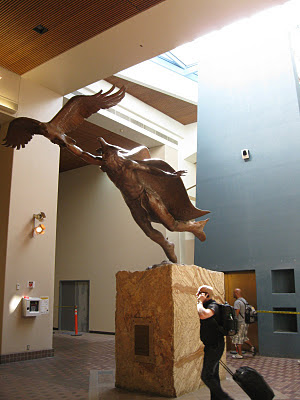
Albuquerque's airport is the noisiest I've ever been in. It's not because of the usual complaint of TVs blaring throughout the concourse. It's the floors.
Albuquerque's 'Sunport,' a handsome complex, has actual brick floors throughout the terminal -- before security, after security, in the bathrooms, everywhere. A touch of southwestern style, I guess.
But when a planeload of passengers all tramp by you en masse with their roller bags, the sound is very much like what happens when you drive on highway rumble strips.
BRAA-GAAA-GAAA-RRRR-RRRR-BRAA-GAAA-GAAA and so on, until the plane empties. And until another one comes in.
Chalk it up to unintended consequences. But still, it doesn't take much away from a nice airport that makes a nice effort to act as a distinctive gateway and an easy-to-use facility.
Not being a hub, the place has only a handful of flights from each of the major carriers, many of them regional jets. But Southwest has long had a presence in Albuquerque, and operates something like three dozen flights a day, or about half the airport's total. (In that sense, Albuquerque is rather like my hometown airport, Manchester-Boston Regional.)
So it's busy enough, but still gets by with a single terminal and two-prong pier. Simple and efficient, and the "grand entrance" is a two-story space about the size of a high school gym, with a replica of an early aircraft hanging from the wooden rafters. Nice!

Post-security, the gate concourse is divided into two piers, with a rather ambitious sculpture acting as a dividing point. It sets the right tone, though it's boxed into a relatively cramped atrium, and is lit from above, making it easy to ignore.

There's some construction going around the sculpture, which led to some partially obscured signage. If you're looking for the "nge," it's this way.


 What I liked about the place, though, was the care that went into the details. Even an ordinary billboard kiosk is done with regional design in mind. A pedestal isn't just a pedestal, but a nicely executed exercise in regional stonework.
What I liked about the place, though, was the care that went into the details. Even an ordinary billboard kiosk is done with regional design in mind. A pedestal isn't just a pedestal, but a nicely executed exercise in regional stonework. The flight info displays are state-of-the-art, but they're enclosed in framework of glass panels etched with a local pattern. (The garbage cans lined up in front take away from that, but they've got to go somewhere.)

And, thankfully, the windows aren't horizontal, but actually provide a good view of the tarmac action. The place seems a little earthbound, but then again the regional "abode" style of construction doesn't really lend itself to glass and air and sunlight, does it?

I like the Albuquerque Sunport. When my wife and I arrived, the flight was late, but at least the airport made us feel we'd arrived somewhere distinctive, and told us a little about what kind of a place it was. That was nice, since in the dark, it would have been hard to tell otherwise.
A side trip to Santa Fe: About an hour's drive north of Albuquerque is Santa Fe, state capital of New Mexico and one of the oldest European settlements on the continent. While most people go there for the art scene, airport enthusiasts will be glad to know that Santa Fe is home to a beautifully intact and fully functioning mid-20th century airline terminal, painted a pueblo beige and complete with control tower on top.

Although overshadowed by Albuquerque's busy Sunport to the south, the capital's airport has long enjoyed some level of commercial air service. At one point, TWA ran many flights through here. Lately, the trend has been on the light side. A few years back, no airlines at all stopped here. Today, it's a grand total of three on American Eagle: two to Dallas and one to Los Angeles. And that's it.
AS a result, Santa Fe's airport hasn't felt the need to expand or change or upgrade, other than to accommodate stricter security. You still just drive right up the terminal or park right next to the tarmac and walk across the road to catch your flight. Need a rental car? They there are, all lined up, steps from the counters inside.

The place was pretty quiet when we stopped by -- no flights just then. I moseyed through the darkened ticket counter space to find a boarding area that looked like the dining room of a well-to-do rancher: high beamed ceilings, simple hung-wheel chandelier, southwest style decorator touches, and a hanging model of the original Boeing 707 Air Force One.

Oh -- and a body scanner.